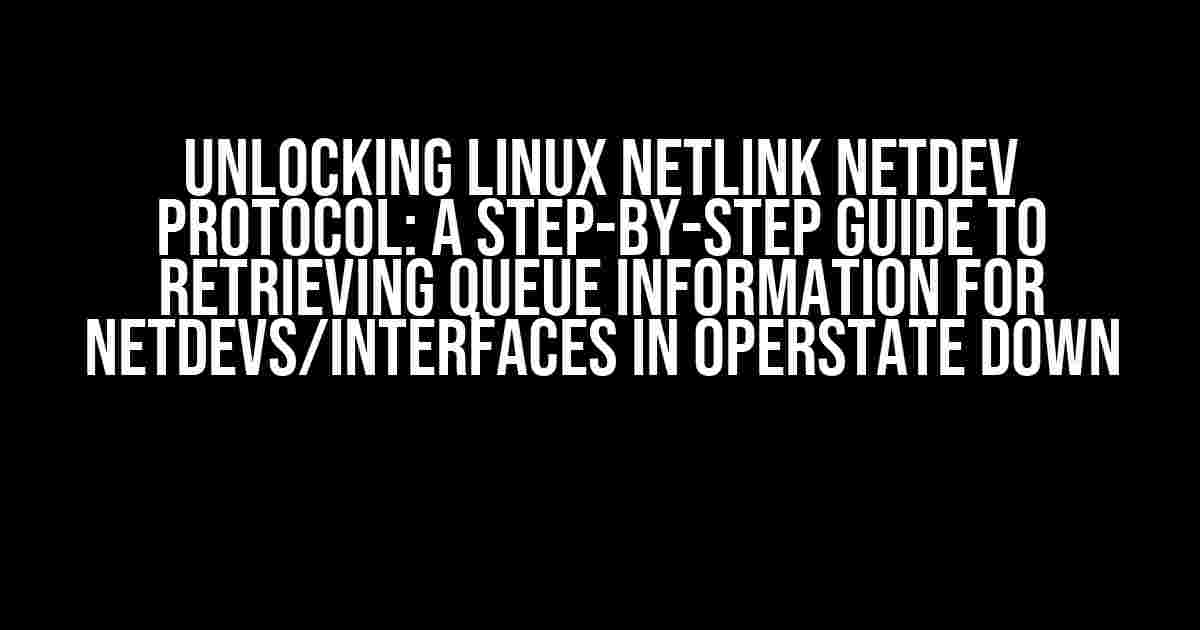Are you tired of scratching your head over the complexities of Linux Netlink Netdev protocol? Do you struggle to get queue information for netdevs/interfaces when they’re in operstate down? Worry no more! In this comprehensive guide, we’ll delve into the world of Netlink Netdev protocol and provide you with clear, direct instructions on how to overcome this challenge.
What is Linux Netlink Netdev Protocol?
Before we dive into the nitty-gritty, let’s take a step back and understand what Linux Netlink Netdev protocol is all about. Netlink is a socket-based interface used for communication between the kernel and user-space processes. The Netdev family, specifically, is responsible for handling network device-related events and queries. It’s a fundamental component of the Linux kernel, enabling us to manage and interact with network interfaces.
The Operstate Down Conundrum
When a network interface is in operstate down, it means the interface is not operational, and no traffic can flow through it. In this state, retrieving queue information can be a challenge. The usual methods, such as querying the interface through ip link show or ethtool, won’t work since the interface is down. This is where Netlink Netdev protocol comes to the rescue!
Understanding Netlink Messages
Netlink messages are the fundamental units of communication between the kernel and user-space processes. They’re composed of a header, followed by a payload. The header contains essential information, such as the message type, flags, and sequence number. The payload, on the other hand, carries the actual data.
In the context of Netdev protocol, we’re interested in the NLMSG_INFO message, which carries information about a specific network device. This message is sent in response to a query from a user-space process.
struct nlmsghdr {
__u32 nlmsg_len; /* Length of message */
__u16 nlmsg_type; /* Message type */
__u16 nlmsg_flags; /* Additional flags */
__u32 nlmsg_seq; /* Sequence number */
__u32 nlmsg_pid; /* Sending process port ID */
};
Retrieving Queue Information using Netlink Netdev Protocol
To retrieve queue information for netdevs/interfaces in operstate down, we’ll use the rtnl_link_get+ and rtnl_link_message functions from the libnetlink library. These functions allow us to send a query to the kernel and receive the response.
Setting up the Environment
Before we start coding, make sure you have the following dependencies installed:
libnetlink-dev(for development)libnetlink3(for runtime)
On Ubuntu-based systems, you can install these dependencies using:
sudo apt-get install libnetlink-dev libnetlink3
Coding the Solution
Create a new C file, e.g., queue_info.c, and add the following code:
#include <linux/rtnetlink.h>
#include <libnetlink.h>
#include <stdio.h>
#include <string.h>
#define BUF_SIZE 1024
int main() {
struct rtnl_link *link;
struct nlmsghdr *nh;
struct ifinfomsg *ifm;
char buf[BUF_SIZE];
int nl_sock, rc;
/* Create a netlink socket */
nl_sock = socket(AF_NETLINK, SOCK_RAW, NETLINK_ROUTE);
if (nl_sock < 0) {
perror("socket");
return 1;
}
/* Initialize the netlink message header */
nh = (struct nlmsghdr *)buf;
nh->nlmsg_len = NLMSG_LENGTH(sizeof(struct ifinfomsg));
nh->nlmsg_type = RTM_GETLINK;
nh->nlmsg_flags = NLM_F_REQUEST;
nh->nlmsg_seq = time(NULL);
/* Add the interface index or name to the message */
ifm = (struct ifinfomsg *)NLMSG_DATA(nh);
ifm->ifi_family = AF_UNSPEC;
ifm->ifi_index = if_nametoindex("eth0"); /* Replace with your interface name */
/* Send the query to the kernel */
rc = send(nl_sock, nh, nh->nlmsg_len, 0);
if (rc < 0) {
perror("send");
return 1;
}
/* Receive the response */
rc = recv(nl_sock, buf, BUF_SIZE, 0);
if (rc < 0) {
perror("recv");
return 1;
}
/* Parse the response */
for (nh = (struct nlmsghdr *)buf; NLMSG_OK(nh, rc); nh = NLMSG_NEXT(nh, rc)) {
if (nh->nlmsg_type == NLMSG_DONE)
break;
if (nh->nlmsg_type == NLMSG_ERROR)
continue;
ifm = (struct ifinfomsg *)NLMSG_DATA(nh);
printf("Interface: %s\n", if_indextoname(ifm->ifi_index, buf));
/* Get the queue information */
struct rtnl_link_stats *stats = IFLA_STATS_LINK((struct ifinfomsg *)NHMSG_DATA(nh));
printf("Queue length: %u\n", stats->rx_queue_len);
printf("Queue max length: %u\n", stats->rx_max_queue_len);
}
close(nl_sock);
return 0;
}
Compile the code using:
gcc -o queue_info queue_info.c -l rtnl -l netlink
Running the Program
Run the program using:
./queue_info
This will display the queue information for the specified interface (in this case, eth0). Make sure to replace eth0 with your desired interface name.
Conclusion
In this article, we’ve explored the world of Linux Netlink Netdev protocol and learned how to retrieve queue information for netdevs/interfaces in operstate down. By using the rtnl_link_get+ and rtnl_link_message functions, we can query the kernel for information about specific network devices, even when they’re not operational.
Remember to adapt the provided code to your specific needs and environment. With this knowledge, you’ll be well-equipped to tackle complex network-related tasks in Linux.
| Function | Description |
|---|---|
rtnl_link_get+ |
Sends a query to the kernel for information about a specific network device |
rtnl_link_message |
Parses the response from the kernel and extracts the relevant information |
NLMSG_INFO |
The Netlink message type used to carry information about a network device |
RTM_GETLINK |
The Netlink message type used to request information about a network device |
I hope you found this article informative and helpful. If you have any questions or need further clarification, feel free to ask in the comments!
References
Frequently Asked Question
Get ready to dive into the world of Linux Netlink Netdev protocol and explore the secrets of obtaining queue information for netdevs/interfaces in operstate down!
Q1: What’s the deal with Linux Netlink Netdev protocol, anyway?
Linux Netlink Netdev protocol is a messaging protocol used for communication between the kernel and user space, specifically for network devices and interfaces. It’s like a messenger between the kernel and user space, allowing them to exchange information and requests regarding network configuration and state.
Q2: Why do I need to get queue information for netdevs/interfaces in operstate down, and what’s the big deal?
When a network interface is in operstate down, it means it’s not operational, and you might want to know what’s happening with its queues. Getting queue information can help you troubleshoot issues, understand how packets are being processed, and even optimize network performance. It’s like peeking under the hood to see how the engine is running (or not running)!
Q3: How do I use the Netlink Netdev protocol to get queue information for netdevs/interfaces in operstate down?
You can use the `rtnl_link` message with the `IFLA_QUEUE` attribute to request queue information. This will return a list of queue info for the specified interface. You can also use tools like `ip` or `tc` to get queue information, but that’s a story for another time…
Q4: Are there any specific Netlink Netdev messages I should use to get queue information?
Yes, my friend! You’ll want to use the `RTM_GETLINK` message to request link information, including queue info. You can also use `RTM_GETQUEUE` to request specific queue information. Just remember to specify the correct interface index and queue ID to get the info you need!
Q5: Are there any gotchas or common mistakes to watch out for when using Netlink Netdev protocol for queue information?
Oh, yeah! One common gotcha is forgetting to check the interface state before requesting queue information. If the interface is down, you won’t get any queue info. Also, make sure to handle errors and invalid responses, as the kernel might not always return the info you’re expecting. And, of course, always double-check your code and testing!


